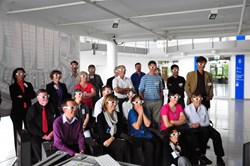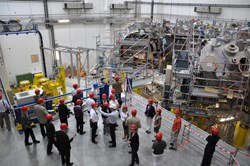
The future is three dimensional: Members of the EFDA Public Information Network watching the latest 3D fusion animation produced by the European Commission. Photo: Gieljan de Vries
The PIG is dead, long live the PIN. Babe the pig is stretched out flat in a large steel casserole, soaking in gravy and vegetables. A flag with three initials is sticking out of its roasted shoulder indicating a new dawn for the assembled 27 communication officers from the fusion labs within Europe, formerly known as the EFDA Public Information Group (PIG).
Finding a less omnivorous name for the group, now called the Public Information Network, was something of a personal matter for Petra Nieckchen, the new head of communication within
EFDA. EFDA is the umbrella organization that unites all the fusion labs in Europe, including those that host the largest existing tokamak, JET, and the latest newcomer to the international stellarator family, Wendelstein W7-X, which is currently being assembled at the Max Planck Institute for Plasmaphysics in Greifswald, in the far north of Germany. It was here in the old Hanse town that the PIN members convened last week for their annual gathering to discuss the means and strategies for promoting potential uses of fusion energy.

IPP spokesman Robert Wolf showing the group around the Wendelstein W7-X assembly hall. Photo: Ralph Schorn
The meeting was opened by EFDA Leader Francesco Romanelli, speaking from the JET Headquarters in Culham, England via webcam. "EFDA," he said, "should act as a catalyst between the different fusion associations in Europe and define the path forward." This path, Romanelli explained further, will lead to the design of a Demonstration Reactor (DEMO). First design activities recently started at the EFDA worksite in Garching, Germany (click
here for more info).
Besides exchanging the latest news from their institutions and the ITER Project, as well as discussing a future communication strategy in a Europe that has, at least partly, changed its perception of nuclear energy, the PIN invited two guest speakers for inspiration. James Gillies, head of communication at
CERN, reported on the months that preceded and followed the start of the LHC, and the subsequent quench of one of its magnets. "Now," Gillies said, quoting Bertold Brecht, "the troubles of the mountains lie behind us. Before us lie the troubles of the planes." The next challenge after the media hype will be to keep the interest in the project.

An ingenious and delicious way to communicate the new name of the Public Information Network, formerly known as the PIG. Photo: Ralph Schorn
The second invited guest speaker to the PIN meeting was Claus Madsen, former communication head at the European Southern Observatory (
ESO) and now senior advisor to EFDA. He chose a slightly modified Hamlet quote, "To Communicate or Not to Be," as the title for his talk about the new world of technology-driven communication. Modern communication tools like blogs, Twitter, Facebook, and YouTube have dramatically changed the media and its pace. "Which doesn't mean that it is now easier to get your message across," Madsen stressed. "Everybody shouts, but who listens?"




